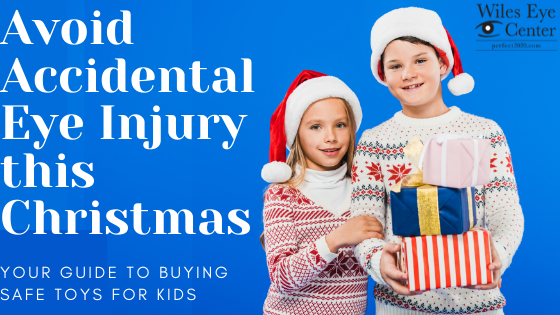
We have all seen or read the warning signs on children’s toys. Most commonly, the choking hazards and the recommended ages for playing with the specific toy. However, something less commonly acknowledged on these warning labels is the risk of blindness due to eye injuries.
With the holidays coming up, this type of injury is very common this time of the year. Although these warning labels are often ignored, toys can be harmful to children. In 2016 alone, there were more than 240,000 Emergency Room visits due to injuries caused by toys*. Since December is the most popular month for gift-giving due to the holidays, it is also Toy Safety Month.
According to the American Academy of Ophthalmology, thousands of children sustain eye injuries and even blindness each year*. Furthermore, nearly 90% of these injuries could have been prevented through the use of protective eyewear*. Due to this increasing number of sustained eye injuries and the unawareness of this issue, it is important for parents, grandparents, and anyone else purchasing toys as a gift to be aware of their abilities in preventing injuries.
The first way to prevent eye injuries sustained from a toy is to only buy age-appropriate toys. If the label on the toy says not suitable for children under the age of 5, then simply don’t buy it for a child under the recommended age. It is also important to consider younger children when purchasing toys for older kids.
Be mindful of pieces that may easily break off, or other pieces of the toys that can pose a potential choking hazard. When purchasing toys, look for those marked with “ASTM.” This means that these toys meet the National Safety Standards set forth by the American Society for Testing and Materials*.
Another way to prevent eye injuries is to make sure that children are always properly supervised while they’re playing. Having an adult present will decrease the chance for accidents involving toys. In addition to proper supervision, it is important to educate children on how to properly use their toys. Before you allow children to use any of their new toys, read the instructions, and warnings, on the box.
It is also recommended to keep toys put away when they’re not in use. Ideally, potentially hazardous toys should be kept in a spot that children can not get to if they’re not being properly supervised for the specific activity. This can include any board games that may have small pieces. Be sure to inspect toys for loose pieces before allowing children to play with them, and throw away any broken toys to avoid accidental injuries.
The single most common toy that causes eye injuries are those that entail projecting smaller pieces. Toys of this kind include dart guns, toy bows and arrows, and missile-firing toys*. It is important to note that pellet guns, bb guns, and airsoft guns have been reclassified and removed from toy sections due to the hazards they entail. If children will be playing with dart guns or toy bows and arrows, it is important that they wear the proper eye protection. Eye protection should be appropriate for the type of activity that is being performed, and they should meet the national safety standards. You can visit the American Academy of Ophthalmology’s website for more information about these safety standards.
In addition to preventing eye injuries from toys during the holiday season, it is also important for parents, other family members, caregivers, and anyone else who may be supervising children while playing to be aware of first aid when eye injuries are involved.
If an eye injury occurs, do not touch, rub, or apply pressure to the eye. Do not try to remove any debris from the eye. If the debris is a small piece, you can lift the eyelid and ask the child to blink rapidly to try and remove the object. If the object does not come out on its own, close the eye and seek help immediately. Avoid applying any ointment or medication to they eye in the event of an injury. Keep in mind, only eye injury that includes hazardous chemicals should be flushed with water. If a cut or puncture of the eye occurs, it should be gently covered before seeking help to avoid any contamination. If an eye injury occurs, it is always a good idea to call your eye doctor for what they recommend for your injury.
If you have any questions or would like to make an appointment, please call us. The number to our Kansas City location is 816-455-2020. Our St. Joseph’s office location can be reached by calling 816-279-7015.
*Attributions:
https://www.preventblindness.org/safe-toy-checklist
https://www.safekids.org/safetytips/field_risks/toy-safety
https://www.aao.org/eye-health/tips-prevention/injuries-children
https://www.cpsc.gov/s3fs-public/Toy_Report_2016.pdf?6ZwpKyiwsEdVzWXhH0m0doo5cJALIZFW

Comments are closed here.